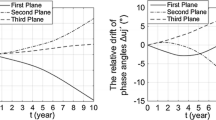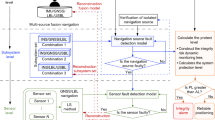Abstract
Advanced receiver autonomous integrity monitoring (ARAIM), based on multi-constellation and dual-frequency, can provide vertical navigation in terminal approaches. The baseline ARAIM receiver algorithm is based on the multiple hypothesis solution separation (MHSS). The fault modes determination scheme, proposed in the ARAIM baseline algorithm, is a sequential structure and a core processing which can be summarized in three steps: calculating the maximum number of simultaneous faults, forming all subsets, and filtering the subsets. The fault modes determined by the maximum number of simultaneous faults are sufficient, but not necessary. A set of redundant fault modes is included, which reduces the ARAIM performance and increases the computation burden. The continuity risk is not considered in the filtering. We propose a new fault modes determination scheme based on feedback structure with probability accumulation. The number of fault modes in the baseline algorithm is defined subject to a given integrity risk requirement. In the proposed algorithm, the fault modes are directly determined subject to this parameter. The fault modes are accumulated in descending order of fault probability. The probability of not monitored risk obtained in probability accumulation is closer to the integrity risk requirement compared to the baseline method, and the number of fault modes is reduced noticeably. The continuity detection is added to the feedback structure to find the severe integrity risk in time. The fault modes, determined in the proposed scheme, are sufficient and necessary. The performance evaluation results under a GPS-Galileo dual-constellation situation for localizer precision vertical 200 (LPV-200) requirements show that the proposed scheme can improve the availability of ARAIM from 84.92 to 92.25%. An enhanced effective monitor threshold (EMT) mainly contributes to this improvement. Furthermore, the proposed scheme also shows positive superiority in calculation load. The reduction in fault modes can directly contribute to the alleviation of the receiver calculation burden, which saves nearly 40% computational time on a PC-based software-defined receiver.





Similar content being viewed by others
References
Blanch J, Walter T, Enge P, Lee Y, Pervan B, Rippl M, Spletter A (2012) Advanced RAIM user algorithm description: Integrity support message processing, fault detection, exclusion, and protection level calculation. In: Proc. ION GNSS 2012, Institute of Navigation, Nashville, September 17–21, pp 2828–2849
Blanch J, Walter T, Enge P (2013) Optimal positioning for advanced RAIM. Navigation 60(4):279–289
Blanch J, Walker T, Enge P, Lee Y, Pervan B, Rippl M, Spletter A, Kropp V (2015) Baseline advanced RAIM user algorithm and possible improvements. IEEE Trans Aerosp Electron Syst 51(1):713–732
Cassel R (2017) Real-time ARAIM Using GPS, GLONASS, and GALILEO. Dissertation, Illinois Institute of Technology
El-Mowafy A (2017) Advanced receiver autonomous integrity monitoring using triple frequency data with a focus on treatment of biases. Adv Space Res 59(8):2148–2157
El-Mowafy A, Yang C (2016) Limited sensitivity analysis of ARAIM availability for LPV-200 over Australia using real data. Adv Space Res 57(2):659–670
Ge Y, Wang Z, Zhu Y (2017) Reduced ARAIM monitoring subset method based on satellites in different orbital planes. GPS Solutions 21(4):1443–1456
GEAS (2010) GNSS evolutionary architecture study, GEAS phase II panel report. FAA, Washington
Joerger M, Pervan B (2016) Fault detection and exclusion using solution separation and chi-squared ARAIM. IEEE Trans Aerosp Electron Syst 52(2):726–742
Khanafseh S, Joerger M, Chan FC, Pervan B (2015) ARAIM integrity support message parameter validation by online ground monitoring. J Navig 68(2):327–337
Kropp V, Eissfeller B, Berz G (2014) Optimized MHSS ARAIM user algorithms: assumptions, protection level calculation and availability analysis. In: Proc. IEEE/ION PLANS 2014, Institute of Navigation, Monterey, May 5–8, pp 308–323
Lee Y, Bian B (2017) Advanced RAIM performance sensitivity to deviations in ISM parameter values. In: Proc. of ION GNSS + 2017, Institute of Navigation, Portland, September 25–29, pp 2338–2358
Meng Q, Liu JY, Zeng QH, Feng SJ, Chen RZ (2017) Neumann–Hoffman code evasion and stripping method for BeiDou Software-defined receiver. J Navig 70(1):101–119
Meng Q, Liu JY, Zeng QH, Feng SJ, Xu R (2018) An efficient BeiDou DBZP-based weak signal acquisition scheme for software-defined receiver. IET Radar Sonar Navig 12(6):654–662
Montenbruck O, Steigenberger P, Hauschild A (2015) Broadcast versus precise ephemerides: a multi-GNSS perspective. GPS Solut 19(2):321–333
Perea S, Meurer M, Rippl M, Belabbas B, Joerger M (2017) URA/SISA analysis for GPS and Galileo to support ARAIM. Navigation 64(2): 237–254
Rippl M, Spletter A, Günther C (2011) Parametric performance study of advanced receiver autonomous integrity monitoring (ARAIM) for combined GNSS constellations. In: Proc. ION ITM 2011, Institute of Navigation, San Diego, Jan 24–26, pp 285–295
Walter T, Blanch J, Enge P (2014) Reduced subset analysis for multi-constellation ARAIM. In: Proc. ION ITM 2014, Institute of Navigation, San Diego, Jan 27–29, pp 89–98
Walter T, Blanch J, Joerger M, Pervan B (2016) Determination of fault probabilities for ARAIM. In: Proc. IEEE/ION PLANS 2016, Institute of Navigation, Savannah, April 11–14, pp 451–461
Working Group C (2013) ARAIM Technical Subgroup Milestone 1. Report of the EU-US Cooperation on Satellite Navigation, Working Group C. https://www.gps.gov/policy/cooperation/europe/2013/working-group-c/
Working Group C (2015) ARAIM Technical Subgroup Milestone 2. Report of the EU-US Cooperation on Satellite Navigation, Working Group C. https://www.gps.gov/policy/cooperation/europe/2015/working-group-c/
Working Group C (2016) ARAIM Technical Subgroup Milestone 3. Report of the EU-US Cooperation on Satellite Navigation, Working Group C. https://www.gps.gov/policy/cooperation/europe/2016/working-group-c/
Wu Y, Liu X, Liu W, Ren J, Lou Y, Dai X, Fang X (2017) Long-term behavior and statistical characterization of BeiDou signal-in-space errors. GPS Solut 21(4):1907–1922
Zhai Y, Joerger M, Pervan B (2015) Continuity and availability in dual-frequency multi-constellation ARAIM. In: Proc. ION GNSS + 2015, Institute of Navigation, Tampa, September 14–18, pp 664–674
Acknowledgements
The authors thank Yawei Zhai in Mechanical and Aerospace Engineering at the Illinois Institute of Technology (IIT) for his valuable help. The receiver software is developed based on the open source MATLAB Availability Analysis Simulation Tools (MAAST) developed by the GPS Lab, Stanford University. Thanks for their outstanding work. This research has been funded by the National Natural Science Foundation of China under Grant Nos. 61533008 & 61374115 & 61328301 & 61603181; the Funding of Jiangsu Innovation Program for Graduate Education under Grant No. KYLX16_0379, Fundamental Research Funds for the Central Universities (NS2015037).
Author information
Authors and Affiliations
Corresponding authors
Additional information
Publisher’s Note
Springer Nature remains neutral with regard to jurisdictional claims in published maps and institutional affiliations.
Rights and permissions
About this article
Cite this article
Meng, Q., Liu, J., Zeng, Q. et al. Improved ARAIM fault modes determination scheme based on feedback structure with probability accumulation. GPS Solut 23, 16 (2019). https://doi.org/10.1007/s10291-018-0809-8
Received:
Accepted:
Published:
DOI: https://doi.org/10.1007/s10291-018-0809-8




